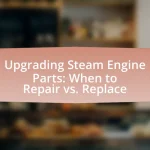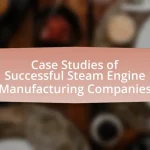The article provides a historical overview of steam engine manufacturing processes, tracing the evolution from early designs to advanced engineering techniques. It highlights key milestones, such as Thomas Newcomen’s atmospheric engine and James Watt’s improvements, which significantly enhanced efficiency and led to widespread adoption in various industries. The article discusses the impact of technological advancements on manufacturing practices, including precision engineering and the use of interchangeable parts, as well as the materials used in production. Additionally, it examines the social and economic implications of steam engine manufacturing during the Industrial Revolution and the challenges faced in the industry, ultimately reflecting on lessons learned that can inform modern manufacturing practices.
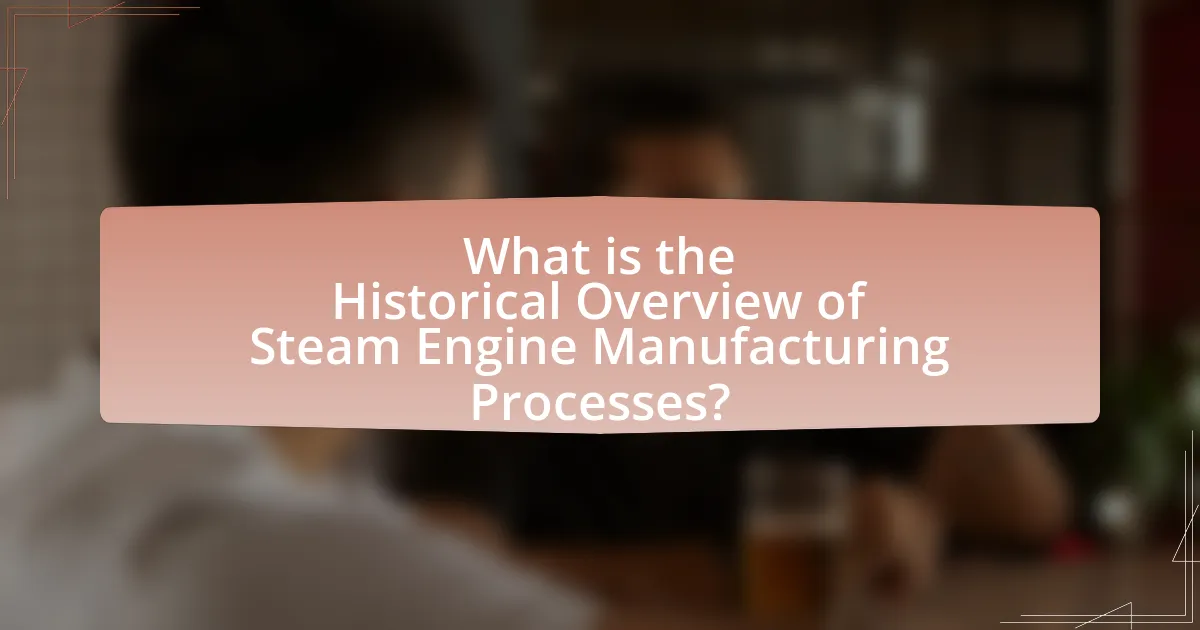
What is the Historical Overview of Steam Engine Manufacturing Processes?
The historical overview of steam engine manufacturing processes reveals a progression from early designs to advanced engineering techniques. The first commercially successful steam engine, developed by Thomas Newcomen in 1712, utilized atmospheric pressure to create motion, marking the beginning of steam power in industry. James Watt’s improvements in the late 18th century, including the separate condenser, significantly enhanced efficiency and led to widespread adoption in various sectors, such as mining and textiles. The manufacturing processes evolved further during the Industrial Revolution, incorporating precision engineering and mass production techniques, exemplified by the use of interchangeable parts and mechanized assembly lines. By the 19th century, steam engines had become integral to transportation, powering locomotives and steamships, which transformed global trade and mobility. This historical trajectory illustrates the significant impact of steam engine manufacturing on industrialization and technological advancement.
How did steam engine manufacturing evolve over time?
Steam engine manufacturing evolved significantly from the early 18th century to the late 19th century, transitioning from simple designs to complex, efficient machines. Initially, steam engines were primarily developed by inventors like Thomas Newcomen, whose atmospheric engine (1712) utilized steam to create a vacuum for pumping water, but was inefficient. The introduction of James Watt’s improvements in the 1760s, including the separate condenser, greatly enhanced efficiency and power output, leading to widespread adoption in industries such as mining and textiles.
By the early 19th century, manufacturing processes began to incorporate precision engineering techniques, allowing for standardized parts and mass production. The establishment of factories specifically for steam engine production, such as those by George Stephenson, further advanced the technology. The introduction of the locomotive in the 1820s and 1830s marked a pivotal moment, as steam engines became integral to transportation, leading to innovations in design and manufacturing methods.
The evolution continued with the advent of the Industrial Revolution, which saw the integration of steam engines into various sectors, including agriculture and manufacturing. By the late 19th century, steam engines had become more reliable and powerful, with advancements in metallurgy and engineering practices, such as the use of high-pressure steam and improved materials, solidifying their role in industrialization.
What were the key milestones in the development of steam engines?
The key milestones in the development of steam engines include the invention of the atmospheric engine by Thomas Newcomen in 1712, which marked the first practical use of steam power for pumping water. In 1765, James Watt improved upon Newcomen’s design by introducing a separate condenser, significantly increasing efficiency and leading to widespread industrial applications. The introduction of the high-pressure steam engine by Richard Trevithick in 1802 further advanced steam technology, enabling locomotion and paving the way for rail transport. Finally, George Stephenson’s locomotive, built in 1825, demonstrated the potential of steam engines in transportation, revolutionizing travel and commerce. These milestones collectively transformed industries and societies, establishing steam engines as a cornerstone of the Industrial Revolution.
How did technological advancements influence steam engine manufacturing?
Technological advancements significantly enhanced steam engine manufacturing by improving efficiency, precision, and production speed. Innovations such as the introduction of interchangeable parts in the early 19th century allowed for mass production, which reduced costs and increased reliability. The development of high-pressure steam engines, exemplified by James Watt’s improvements in the 1760s, increased power output and efficiency, enabling engines to be used in various industries beyond transportation. Additionally, advancements in metallurgy and materials science led to stronger and lighter components, further optimizing engine performance. These changes collectively transformed steam engine manufacturing into a more systematic and scalable process, facilitating the Industrial Revolution.
What were the primary materials used in steam engine manufacturing?
The primary materials used in steam engine manufacturing were iron and brass. Iron was predominantly utilized for the engine’s frame, boiler, and various components due to its strength and durability. Brass, an alloy of copper and zinc, was commonly used for fittings, valves, and other parts that required corrosion resistance and machinability. Historical records indicate that the use of these materials was essential for the efficiency and longevity of steam engines, particularly during the Industrial Revolution when advancements in metallurgy improved manufacturing processes.
How did the choice of materials impact the performance of steam engines?
The choice of materials significantly impacted the performance of steam engines by influencing their efficiency, durability, and safety. For instance, the use of cast iron for boiler construction allowed for higher pressure containment, which improved steam generation and overall power output. Additionally, the introduction of steel in later designs enhanced strength and reduced weight, leading to more efficient engines. Historical data shows that early steam engines made from wrought iron had limitations in pressure tolerance, often resulting in failures, while advancements in material science led to engines capable of operating at higher pressures, thus increasing their operational efficiency and lifespan.
What innovations in materials were introduced during the steam engine era?
During the steam engine era, significant innovations in materials included the development of cast iron and wrought iron, which enhanced the strength and durability of engine components. Cast iron was utilized for engine frames and cylinders due to its ability to withstand high pressure and temperature, while wrought iron was favored for its malleability and tensile strength, making it ideal for parts like connecting rods and boiler tubes. The introduction of these materials allowed for more efficient steam engines, as evidenced by the advancements made by engineers such as James Watt, who improved engine design and performance through the use of these stronger materials.
What role did steam engine manufacturing play in the Industrial Revolution?
Steam engine manufacturing was pivotal in the Industrial Revolution as it enabled the mechanization of production processes and transportation. The introduction of steam engines significantly increased efficiency in industries such as textiles and mining, allowing for faster production rates and reduced labor costs. For instance, James Watt’s improvements to the steam engine in the late 18th century enhanced its power and efficiency, leading to widespread adoption in factories and locomotives. This transition facilitated the growth of railways, which revolutionized the movement of goods and people, further accelerating industrial growth. The steam engine’s role in powering machinery and transportation systems was a cornerstone of the Industrial Revolution, fundamentally transforming economies and societies.
How did steam engines contribute to industrial growth and expansion?
Steam engines significantly contributed to industrial growth and expansion by enabling efficient transportation and mechanization of production processes. The introduction of steam power allowed factories to increase production rates and reduce reliance on manual labor, leading to higher output and lower costs. For example, the steam locomotive revolutionized the movement of goods and raw materials, facilitating trade and access to markets. By the mid-19th century, railways expanded rapidly, with over 20,000 miles of track laid in the United States alone, demonstrating the transformative impact of steam engines on industry and commerce.
What were the social and economic impacts of steam engine manufacturing?
The social and economic impacts of steam engine manufacturing were profound, leading to significant changes in industry and society. Economically, steam engines revolutionized transportation and manufacturing, facilitating the Industrial Revolution by enabling faster production and distribution of goods, which increased trade and commerce. For instance, the introduction of steam-powered locomotives reduced travel time and costs, contributing to the expansion of rail networks and boosting industries such as coal and iron. Socially, steam engine manufacturing led to urbanization as people moved to cities for factory jobs, altering demographics and lifestyles. This shift resulted in the rise of a working class and changes in social structures, including labor movements advocating for workers’ rights. The combination of these economic advancements and social transformations marked a pivotal moment in history, reshaping economies and societies across the globe.
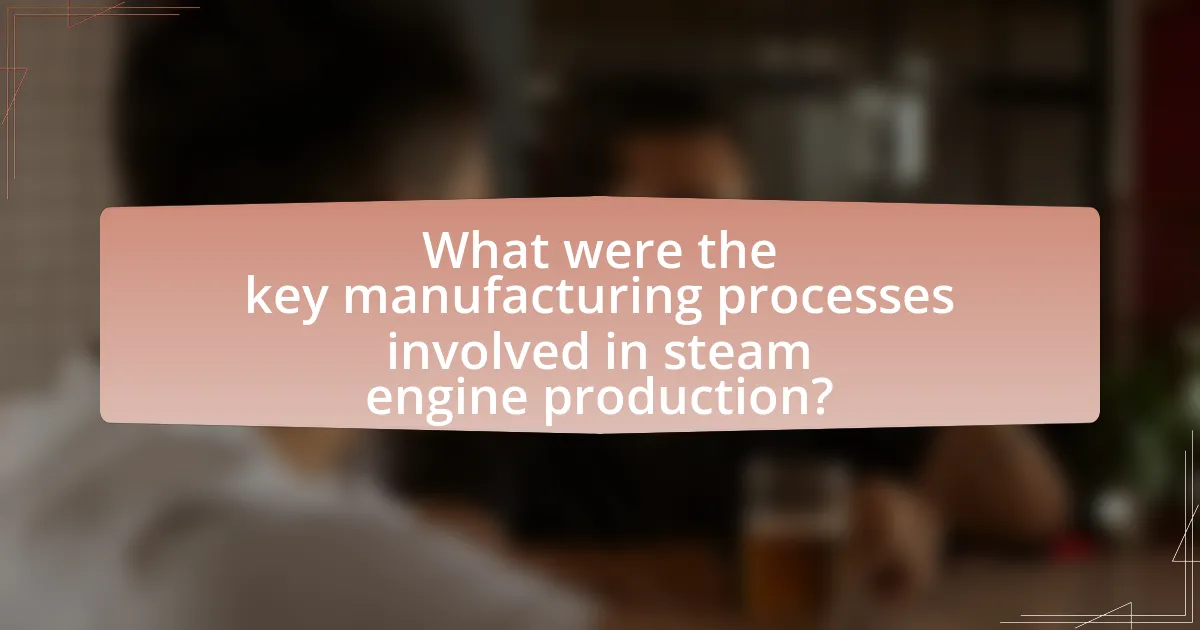
What were the key manufacturing processes involved in steam engine production?
The key manufacturing processes involved in steam engine production included casting, machining, assembly, and testing. Casting was essential for creating the engine’s components, such as the cylinder and boiler, using materials like iron and brass. Machining followed, where these cast components were precisely shaped and finished to ensure proper fit and function. Assembly involved putting together the various parts, including the piston, crankshaft, and valves, to form a complete engine. Finally, testing was conducted to verify the engine’s performance and safety, ensuring it met operational standards. These processes were critical in the development of efficient and reliable steam engines during the Industrial Revolution.
How were steam engines assembled during the manufacturing process?
Steam engines were assembled through a systematic process involving the integration of various components such as the boiler, cylinder, and piston. Initially, manufacturers fabricated individual parts using materials like cast iron and steel, which were then machined to precise specifications. Following this, the assembly began with the boiler, which was constructed by welding or riveting steel plates to form a pressure vessel.
Next, the cylinder was attached to the boiler, and the piston was inserted into the cylinder, ensuring proper alignment for efficient movement. The connecting rods and crankshaft were then installed to link the piston to the flywheel, facilitating the conversion of linear motion into rotational motion. Finally, the entire assembly was tested for leaks and functionality, ensuring that all components worked harmoniously. This methodical approach to assembly was crucial for the steam engine’s performance and reliability, as evidenced by the widespread adoption of steam engines in the 18th and 19th centuries, which revolutionized transportation and industry.
What steps were involved in the assembly of a steam engine?
The assembly of a steam engine involves several key steps: first, the construction of the engine frame, which provides structural support; second, the installation of the boiler, where water is heated to create steam; third, the fitting of the cylinder and piston assembly, which converts steam pressure into mechanical motion; fourth, the attachment of the connecting rods and crankshaft, which transmit motion to the wheels or other machinery; and finally, the installation of the control mechanisms and safety features. Each of these steps is critical to ensure the steam engine operates efficiently and safely, reflecting the engineering principles established during the Industrial Revolution.
How did assembly techniques vary between different manufacturers?
Assembly techniques varied significantly between different manufacturers of steam engines due to differences in design philosophies, production scales, and technological advancements. For instance, companies like Boulton and Watt employed precision engineering and standardized parts, which allowed for interchangeable components, enhancing efficiency and reducing assembly time. In contrast, smaller manufacturers often relied on more traditional, artisanal methods, leading to variations in quality and assembly processes. Historical records indicate that the adoption of assembly line techniques by larger firms in the late 19th century further differentiated manufacturing practices, as it allowed for mass production and reduced costs, exemplified by companies such as the American Locomotive Company. These variations in assembly techniques reflect the broader evolution of manufacturing practices during the industrial revolution.
What machining techniques were essential for steam engine manufacturing?
The essential machining techniques for steam engine manufacturing included turning, milling, drilling, and grinding. Turning was crucial for shaping cylindrical components like pistons and shafts, while milling allowed for the creation of flat surfaces and complex shapes necessary for engine parts. Drilling was used to create precise holes for assembly and functionality, and grinding provided the finishing touches to ensure tight tolerances and smooth surfaces. These techniques were foundational in the 18th and 19th centuries, as they enabled the production of reliable and efficient steam engines, which were pivotal to the Industrial Revolution.
How did precision machining affect steam engine performance?
Precision machining significantly improved steam engine performance by enhancing the accuracy of component dimensions and reducing friction. This increased efficiency allowed steam engines to operate at higher pressures and speeds, leading to greater power output. For instance, the introduction of precision machining techniques in the 19th century, such as the use of lathes and milling machines, enabled manufacturers to produce parts with tolerances of less than one-thousandth of an inch. This level of precision minimized wear and tear on moving parts, resulting in longer operational lifespans and reduced maintenance costs. Historical evidence shows that steam engines manufactured with precision machining could achieve efficiencies exceeding 10%, compared to earlier models, which often struggled with misalignment and excessive friction.
What innovations in machining were developed for steam engine production?
Innovations in machining developed for steam engine production include the introduction of precision machining techniques, such as the use of the slide rest lathe and milling machines. These advancements allowed for the accurate shaping of engine components, which was crucial for the efficient operation of steam engines. The slide rest lathe, invented by Henry Maudslay in the early 19th century, enabled the production of cylindrical parts with high precision, significantly improving the quality and reliability of steam engine components. Additionally, the development of interchangeable parts, pioneered by Eli Whitney, facilitated mass production and repair of steam engines, further enhancing manufacturing efficiency. These innovations collectively transformed steam engine production, leading to more reliable and powerful engines during the Industrial Revolution.
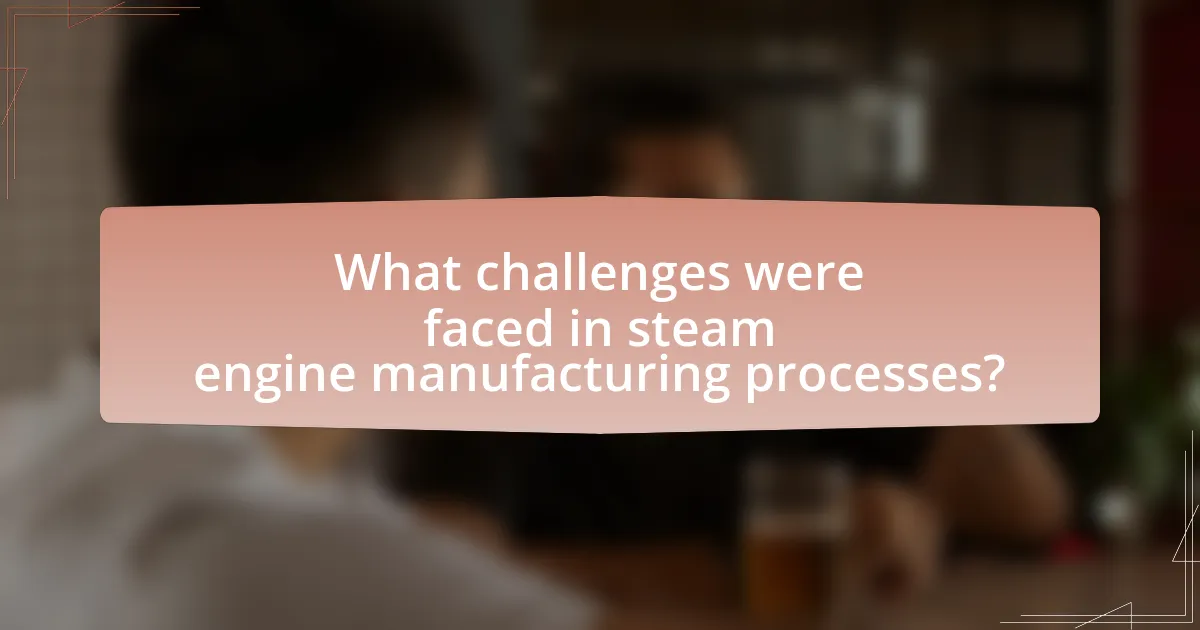
What challenges were faced in steam engine manufacturing processes?
Steam engine manufacturing processes faced significant challenges, including the need for precise engineering, material limitations, and safety concerns. The complexity of designing components that could withstand high pressure and temperature required advanced engineering skills, which were often lacking in early manufacturing settings. Additionally, the availability of quality materials, such as strong metals for boiler construction, was limited, leading to failures and inefficiencies. Safety was a major issue, as early steam engines were prone to explosions due to inadequate pressure regulation and poor construction practices. Historical records indicate that these challenges contributed to slow advancements in steam engine technology during the Industrial Revolution.
What were the common issues encountered during the manufacturing of steam engines?
Common issues encountered during the manufacturing of steam engines included difficulties in precision engineering, material quality, and assembly. Precision engineering was crucial because steam engines required exact measurements for components to function effectively; inaccuracies often led to inefficiencies or failures. Material quality posed challenges as early manufacturers relied on iron and other metals that could vary in strength and durability, impacting the engine’s performance and lifespan. Additionally, assembly issues arose from the complexity of integrating various parts, which sometimes resulted in misalignments or operational failures. Historical records indicate that these challenges were significant in the early 19th century, as manufacturers like James Watt faced obstacles in standardizing production methods to improve reliability and efficiency.
How did manufacturers address quality control in steam engine production?
Manufacturers addressed quality control in steam engine production through standardized parts and rigorous testing protocols. The introduction of interchangeable parts allowed for consistent assembly and repair, significantly reducing variability in engine performance. Additionally, manufacturers implemented systematic inspection processes, where components were tested for durability and functionality before assembly. Historical records indicate that companies like Boulton and Watt utilized detailed specifications and quality checks, ensuring that each steam engine met established performance criteria, thereby enhancing reliability and efficiency in operation.
What safety concerns arose in the manufacturing process of steam engines?
Safety concerns in the manufacturing process of steam engines primarily included the risk of boiler explosions, inadequate materials leading to structural failures, and the dangers associated with high-pressure steam. Boiler explosions were a significant hazard, as early steam engines often used poorly constructed boilers that could not withstand the pressure, resulting in catastrophic failures; for instance, the boiler explosion of the SS Grandcamp in 1947 highlighted the potential for disaster. Additionally, the use of low-quality iron and steel in construction contributed to the risk of fractures and collapses during operation. The high-pressure steam generated in these engines posed a threat to workers, as any leaks or ruptures could lead to severe injuries or fatalities. These concerns prompted the establishment of safety regulations and standards in the industry to mitigate risks.
How did the decline of steam engine manufacturing impact the industry?
The decline of steam engine manufacturing significantly impacted the industry by leading to a shift towards more efficient technologies, such as internal combustion engines and electric motors. This transition resulted in reduced demand for steam engines, which in turn caused many manufacturers to either pivot to new technologies or cease operations altogether. Historical data indicates that by the mid-20th century, steam engines were largely replaced in transportation and industrial applications, leading to a decline in jobs and expertise related to steam technology. Consequently, the industry experienced a consolidation of manufacturing capabilities, focusing on modern engines that offered greater efficiency and reliability.
What factors led to the decline of steam engine manufacturing?
The decline of steam engine manufacturing was primarily driven by the advent of more efficient internal combustion engines and electric motors. These alternatives offered greater efficiency, lower operational costs, and reduced maintenance requirements compared to steam engines. By the early 20th century, internal combustion engines became the preferred choice for automobiles and other vehicles, significantly diminishing the demand for steam engines. Additionally, advancements in electrical engineering led to the widespread adoption of electric motors in industrial applications, further contributing to the decline. The transition to these technologies was marked by the development of the Ford Model T in 1908, which popularized gasoline engines, and the expansion of electrical infrastructure, making electric power more accessible.
How did the transition to alternative technologies affect steam engine manufacturers?
The transition to alternative technologies significantly diminished the market for steam engine manufacturers. As electric and internal combustion engines became more efficient and versatile in the late 19th and early 20th centuries, steam engines faced declining demand in various sectors, including transportation and industrial applications. For instance, by the 1920s, electric locomotives began to replace steam engines on many railroads, leading to a substantial reduction in steam engine production. This shift forced many manufacturers to either adapt their production lines to accommodate new technologies or face bankruptcy, as evidenced by the closure of numerous steam engine factories during this period.
What lessons can be learned from the historical overview of steam engine manufacturing processes?
The historical overview of steam engine manufacturing processes reveals key lessons about innovation, standardization, and the importance of iterative design. The evolution from early, inefficient designs to more advanced models, such as James Watt’s improvements in the late 18th century, illustrates how incremental advancements can lead to significant efficiency gains. Additionally, the establishment of standardized parts during the Industrial Revolution facilitated mass production, demonstrating that uniformity can enhance productivity and reduce costs. These historical developments underscore the necessity of embracing technological advancements and the value of systematic approaches in manufacturing processes.
How can modern manufacturing benefit from the history of steam engine production?
Modern manufacturing can benefit from the history of steam engine production by leveraging the foundational principles of mechanization and efficiency established during that era. The steam engine revolutionized production processes in the 18th and 19th centuries by introducing reliable power sources that increased productivity and reduced labor costs. For instance, the introduction of James Watt’s improved steam engine in 1776 allowed factories to operate machinery more efficiently, leading to mass production techniques that are still relevant today. By studying these historical advancements, modern manufacturers can adopt similar strategies for optimizing energy use, enhancing automation, and improving supply chain logistics, ultimately leading to increased competitiveness and innovation in manufacturing practices.
What best practices from steam engine manufacturing can be applied today?
Best practices from steam engine manufacturing that can be applied today include precision engineering, standardized parts, and iterative design processes. Precision engineering ensures that components fit together accurately, which reduces wear and increases efficiency; this principle is evident in modern manufacturing techniques such as CNC machining. Standardized parts, as pioneered by steam engine manufacturers, facilitate mass production and simplify repairs, a practice that is foundational in today’s automotive and electronics industries. Iterative design processes, where prototypes are tested and refined, mirror contemporary agile methodologies in product development, enhancing innovation and responsiveness to market needs. These practices have been validated by their successful application in various modern industries, demonstrating their enduring relevance.

